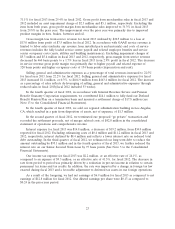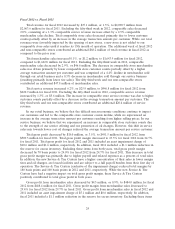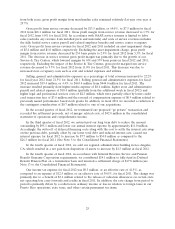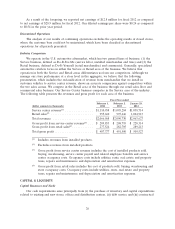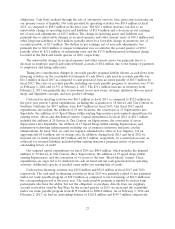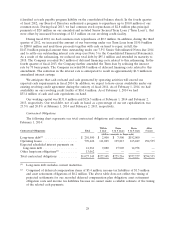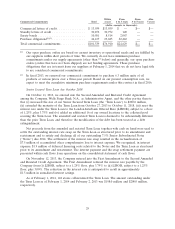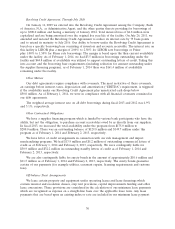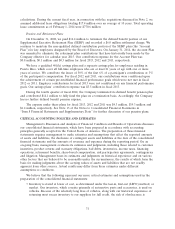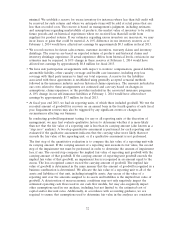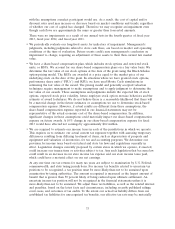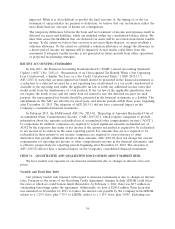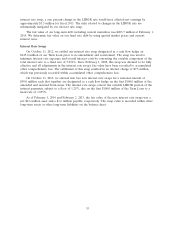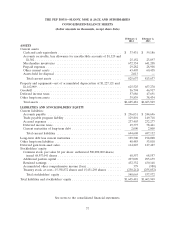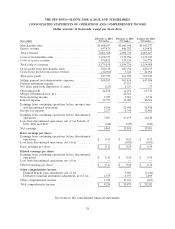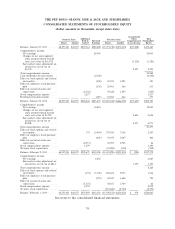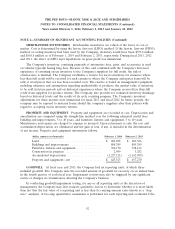Pep Boys 2013 Annual Report Download - page 105
Download and view the complete annual report
Please find page 105 of the 2013 Pep Boys annual report below. You can navigate through the pages in the report by either clicking on the pages listed below, or by using the keyword search tool below to find specific information within the annual report.with the assumptions a market participant would use. As a result, the cost of capital and/or
discount rates used may increase or decrease based on market conditions and trends, regardless
of whether our cost of capital has changed. Therefore we may recognize an impairment even
though cash flows are approximately the same or greater than forecasted amounts.
There were no impairments as a result of our annual tests in the fourth quarter of fiscal year
2013, fiscal year 2012, and fiscal year 2011.
• We periodically evaluate our long-lived assets for indicators of impairment. Management’s
judgments, including judgments related to store cash flows, are based on market and operating
conditions at the time of evaluation. Future events could cause management’s conclusion on
impairment to change, requiring an adjustment of these assets to their then current fair market
value.
• We have a share-based compensation plan, which includes stock options and restricted stock
units, or RSUs. We account for our share-based compensation plans on a fair value basis. We
determine the fair value of our stock options at the date of the grant using the Black-Scholes
option-pricing model. The RSUs are awarded at a price equal to the market price of our
underlying stock on the date of the grant. In situations where we have granted stock options,
performance share units (‘‘PSUs’’) and RSUs, we have used Monte Carlo simulations in
estimating the fair value of the award. The pricing model and generally accepted valuation
techniques require management to make assumptions and to apply judgment to determine the
fair value of our awards. These assumptions and judgments include the expected life of stock
options, expected stock price volatility, future employee stock option exercise behaviors and the
estimate of award forfeitures. We do not believe there is a reasonable likelihood that there will
be a material change in the future estimates or assumptions we use to determine stock-based
compensation expense. However, if actual results are different from these assumptions, the
share-based compensation expense reported in our financial statements may not be
representative of the actual economic cost of the share-based compensation. In addition,
significant changes in these assumptions could materially impact our share-based compensation
expense on future awards. A 10% change in our share-based compensation expense for fiscal
2013 would have affected net earnings by approximately $0.2 million.
• We are required to estimate our income taxes in each of the jurisdictions in which we operate.
This requires us to estimate our actual current tax exposure together with assessing temporary
differences resulting from differing treatment of items, such as depreciation of property and
equipment and valuation of inventories, for tax and accounting purposes. We determine our
provision for income taxes based on federal and state tax laws and regulations currently in
effect. Legislation changes currently proposed by certain states in which we operate, if enacted,
could increase our transactions or activities subject to tax. Any such legislation that becomes law
could result in an increase in our state income tax expense and our state income taxes paid,
which could have a material effect on our net earnings.
At any one time our tax returns for many tax years are subject to examination by U.S. Federal,
commonwealth, and state taxing jurisdictions. For income tax benefits related to uncertain tax
positions to be recognized, a tax position must be more-likely-than-not to be sustained upon
examination by taxing authorities. The amount recognized is measured as the largest amount of
benefit that is greater than 50 percent likely of being realized upon ultimate settlement. An
uncertain income tax position will not be recognized in the financial statements unless it is
more-likely-than-not to be sustained. We adjust these tax liabilities, as well as the related interest
and penalties, based on the latest facts and circumstances, including recently published rulings,
court cases, and outcomes of tax audits. To the extent our actual tax liability differs from our
established tax liabilities for unrecognized tax benefits, our effective tax rate may be materially
33


